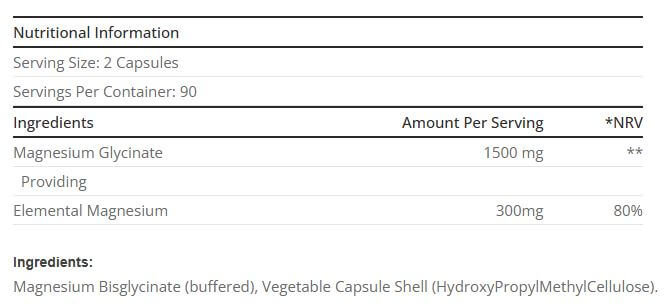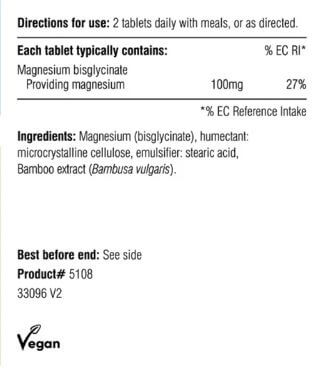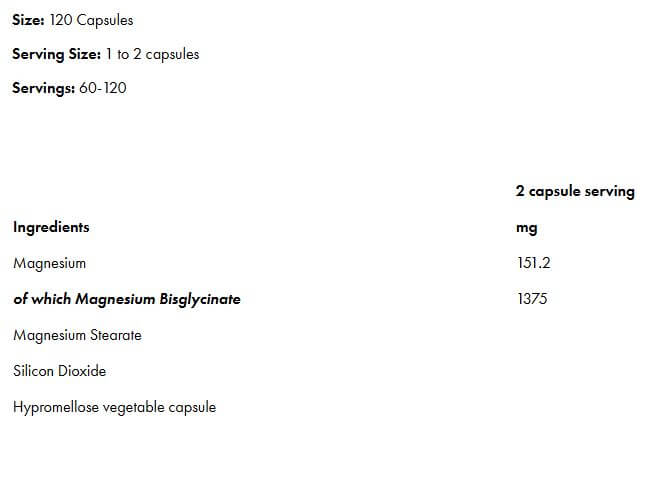Understanding and Interpreting Magnesium Supplement Labels for Proper Dosing
What is Magnesium?
Magnesium is a wonderfully helpful element that aids sleep, something we know a lot about!
It is naturally occurring in a wide variety of food, such as green leafy vegetables, legumes (peas, beans and lentils), nuts, seeds, whole grains, fish and fruits such as bananas and apples.
Even though it can be found in many fibre-rich foods, it can be hard to eat enough foods high in magnesium to get a sufficient amount into your body, which is why many people take magnesium supplements.
Magnesium is actually a metal and is important for so many of our body’s processes. It’s elemental symbol is Mg, not to be confused with milligrams, mg and how much we take depends on the type of magnesium supplement.
Taking magnesium promotes better sleep by helping muscles recover and relax, regulating sleep patterns by balancing melatonin levels and aiding stress hormone responses leading to feelings of calm, relaxation and peace.
It’s no wonder this clever metal is so popular.
But figuring out which type of magnesium to take, how much to take and how to decipher magnesium supplement tablets can be tricky so let’s take a deep dive into types of elemental magnesium, how they help us and how to decide how much to take.

What Does Magnesium Do For The Body?
Magnesium benefits us in several different ways. It helps maintain a normal blood pressure, aids bone strength, muscle recovery, controls blood sugar levels and helps to make proteins and DNA.
Different types of magnesium provide a wide range of health benefits but getting the right kind and dosage of magnesium for the results you require is vital.
What Are The Magnesium Benefits
• Blood pressure – magnesium helps blood vessels relax reducing tension and maintains a healthy blood pressure.
• Bone strength – magnesium is used by our bodies to aid bone formation and people with higher levels of magnesium in their bodies have a higher bone mineral density. Magnesium essentially helps our bodies to use calcium and vitamin D which are both bone-building nutrients.
• Muscle function – magnesium helps muscles to relax after contracting which aids muscle recovery, reduces lactic acid build up and may even improve exercise performance.
It is also crucial in muscle formation as it is used to build the proteins needed for maintaining muscle health.
• Metabolism – magnesium contributes to the process of converting glucose into energy, burning fat, building proteins as mentioned above, and metabolising carbohydrates, fats and amino acids.
Magnesium can increase calorie and fat burning by optimising your metabolic rate, even during periods of rest.
• Sleep – magnesium helps muscles relax, regulates neurotransmitters that relay signals through our central nervous system, helps to regulate melatonin levels (that helpful sleep-inducing hormone) and reduces cortisol, which is a stress hormone, all of which promotes a better night’s sleep.
As mentioned at the start eating plenty of foods high in magnesium is one way of absorbing magnesium into the body but often the magnesium content of foods naturally high in magnesium can be reduced during processing.
This can make it difficult to get enough magnesium through diet alone. This is when a magnesium supplement can be useful to ensuring we get all those healing health benefits.

What Are The Types of Magnesium?
Magnesium is an important part of over 300 enzyme systems that regulate biochemical reactions inside our bodies
Research into the uses and benefits of magnesium supplements is still ongoing but it is known to play a crucial role, not only in the functions listed already, but in many more besides.
It’s no wonder this helpful metal is fast gaining in popularity, especially as it is estimated that more people are deficient in magnesium than not.
There are 10 main types of magnesium supplement, some of which are best as dietary supplements whilst others have more topical uses.
Let’s take a quick look at each of these and what benefits they may have.
1. Magnesium Glycinate Supplement
Magnesium combined with the amino acid glycine is highly absorbable and is taken for stress reduction, to aid relaxation and promote good sleep health.
2. Magnesium Citrate Supplement
Magnesium citrate is magnesium bound with citric acid. It is one of the most popular magnesium supplements as it is easily absorbed and is used to aid digestion and treat constipation due to its laxative effects.
It is also used for replenishing low magnesium levels.
3. Magnesium Oxide Supplement
This is magnesium bound with oxygen to make a salt. It is not easily absorbed by the body but is used to aid digestive issues such as indigestion, constipation and heartburn.
4. Magnesium Malate Supplement
Magnesium malate includes malic acid and is easily absorbed by our bodies. It is thought to have a less laxative effect than other magnesium supplements and has been recommended for the treatment of fibromyalgia, a chronic pain disorder, and those with chronic fatigue.
5. Magnesium Taurate Supplement
Made by combining magnesium with the amino acid taurine, magnesium taurate is thought to be effective at managing high blood sugar, high blood pressure and promoting general heart health.
6. Magnesium L-threonate Supplement
Magnesium L-threonate is a salt made by mixing magnesium with threonic acid, a substance produced from breaking down vitamin c.
It is believed that this type of magnesium is has brain health benefits and may be useful in treating disorders such as depression and memory loss.
7. Magnesium Sulphate
Made from magnesium, oxygen and sulphur, magnesium sulphate is most commonly known as Epsom salt.
Epsom Salts have an unpleasant taste therefore is not widely used as a consumable supplement however it can be dissolved in bath water to use as a muscle relaxant and stress reliever to great effect.
8. Magnesium Chloride
Magnesium chloride is a salt made from magnesium and chlorine, known for its versatility.
It can be taken as an oral supplement due to its high bioavailability, making it effective for increasing magnesium levels in the body.
However, it is more commonly used in topical applications, such as magnesium flakes, creams, or sprays, which help soothe muscle soreness and promote relaxation when added to baths.
9. Magnesium Lactate Supplement
Lactic acid combined with magnesium is most typically used as a preservative food additive. It is easily absorbed though and makes an effective magnesium supplement for those with sensitive digestive systems.

Which Magnesium Supplement is Best?
Your reason for taking magnesium will determine which type of magnesium supplement is best for you. For better sleep, look for magnesium glycinate. For muscle recovery use magnesium sulphate.
Magnesium L-threonate may improve brain health and magnesium taurate can be taken for better heart health.
What is Elemental Magnesium?
Now that we know more about the different types of magnesium, let’s take a look at how these are conveyed on magnesium supplement labels.
To get the most out of your magnesium supplement you need to know how much elemental magnesium is contained, not just the overall compound weight.
Typically, recommended daily intake amounts for magnesium are for elemental magnesium, not compound magnesium, which all of the above types of magnesium are.
Therefore trying to understand your magnesium supplement label can be tricky. Which is why we’re here to help!
Elemental magnesium is the amount of actual magnesium found in the different compound types of magnesium mentioned above.
For example, the magnesium glycinate elemental content is 14.1%. This means that there is 14.1% or 14.1mg of elemental magnesium in 100g of magnesium glycinate.
Keep reading to see how understanding this will help you decipher your magnesium supplement dosage requirements based on the type of magnesium you use.

How to Read Magnesium Supplement Labels
The table below shows the typical magnesium food supplement amount required by children and adults.
Magnesium supplements come in a range if guises, from magnesium tablets to magnesium drops used to make a magnesium liquid form, magnesium gummies and multivitamin magnesium, where magnesium is combined with other vitamins that have complimentary benefits.
You can also get hold of magnesium oil spray which is typically magnesium chloride and acts as a topical muscle relaxant for soothing aches and pains.
However you choose to consume your magnesium, understanding the dosage will ensure that you are getting the right amount without any unwanted side effects
| Group | Age Range | Recommended Daily Intake (mg) | Notes |
|---|---|---|---|
| Children | 1–3 years | 80 mg | Lower dosage suitable for young children. |
| Children | 4–8 years | 130 mg | Increased need for growth and development. |
| Children | 9–13 years | 240 mg | Adjusted for pre-teen nutritional needs. |
| Teenagers | 14–18 years | Boys: 410 mg Girls: 360 mg |
Higher for boys due to greater muscle and bone development. |
| Adults | 19–30 years | Men: 400 mg Women: 310 mg |
Adjusted for average adult metabolic needs. |
| Adults | 31+ years | Men: 420 mg Women: 320 mg |
Slightly higher for men in older age groups. |
| Pregnant Women | All ages | 350–360 mg | Magnesium supports foetal development and prevents cramps during pregnancy. |
| Breastfeeding Women | All ages | 310–320 mg | Magnesium assists with lactation needs. |
| Older Adults | 65+ years | Men: 420 mg Women: 320 mg |
Important for bone health and reducing muscle cramps. |
| Athletes | Men | 450–550 mg+ | Higher needs due to muscle recovery and energy metabolism. |
| Athletes | Women | 350–450 mg+ | Adjusted based on physical activity and body weight. |
Important Considerations for Magnesium Dosage
General Guidelines: The recommended daily intake values in the table are based on general guidelines from reputable sources such as the NHS and international health organisations.
These recommendations provide a useful reference for maintaining adequate magnesium levels for various age groups and life stages.
Athletes and Special Conditions: Athletes and individuals with specific medical conditions, such as magnesium deficiency or those under intensive physical activity, may require personalised dosage recommendations.
These should be determined under the guidance of a healthcare professional to ensure safe and effective intake.
Supplement Labels: Always refer to the specific dosage instructions on magnesium supplement labels.
These are often tailored to the form of magnesium (e.g., magnesium citrate, glycinate) and the amount of elemental magnesium provided per serving.
Consult a Healthcare Professional: If you are unsure about your magnesium needs, or if you experience symptoms of deficiency or excess, consult with a healthcare provider.
They may recommend a magnesium blood test to monitor your levels and adjust supplementation as needed.
Balanced Diet First: While supplements can help fill gaps, aim to meet your magnesium needs through a balanced diet rich in magnesium-containing foods such as green leafy vegetables, nuts, seeds, legumes, and whole grains.
By understanding these guidelines and consulting professionals when necessary, you can optimise your magnesium intake to support overall health and well-being.
Magnesium Supplement Label Examples
Below are some examples of Magnesium supplement labels. Some labels will show the %RI which is the percentage recommended intake, based on your age.
This may also be shown as RDA which stands for recommended daily allowance.
The magnesium tablet dose needed will depend on the type of magnesium supplement you are taking and how much elemental magnesium that type contains.
Other will be more explicit and show a breakdown of how much elemental magnesium is contained and show how many magnesium capsules to take per day to get the recommended intake.

Magnesium Glycinate Label 1
This supplement provides 300mg of elemental magnesium per serving (2 capsules). Compared to the other labels, this is the most potent option for elemental magnesium. For someone focusing on their elemental magnesium intake, this provides:
- 75% of the daily requirement for adult men (400mg) and 96% for adult women (310mg).
- Athletes: Male athletes aiming for 450mg would only need 1 extra capsule (3 total) to meet their target. Female athletes requiring 310–350mg can meet their needs with the standard 2-capsule serving.
This supplement is ideal for those who need a high dose of elemental magnesium in fewer capsules, particularly athletes or individuals with high magnesium demands.

Magnesium Glycinate Label 2
Each tablet contains 100mg of elemental magnesium, with the recommended 2 tablets providing 200mg total. This lower dose makes it suitable for those who need more control over their magnesium intake. For elemental magnesium:
- 50% of the daily requirement for men and 65% for women is met with 2 tablets.
- Athletes: Male athletes would need 4-5 tablets to reach 400–450mg of elemental magnesium. Female athletes could take 3–4 tablets to meet their target of 310–350mg.
This supplement is best for individuals who prefer splitting their doses throughout the day or those starting with smaller amounts of elemental magnesium.

Magnesium Glycinate Label 3
This supplement offers 151.2mg of elemental magnesium per 2 capsules, making it the most moderate in terms of elemental magnesium content. For someone focused on their elemental magnesium intake:
- It provides 36% of the daily requirement for men and 47% for women per serving.
- Athletes: Male athletes would need 3 servings (6 capsules) to reach 450mg, while female athletes would need 2-3 servings (4–6 capsules) to hit 310–350mg.
This supplement works well for those who prefer a lower dose of elemental magnesium per serving and want to tailor their intake based on dietary magnesium or other supplements.
Final Comparison: Elemental Magnesium Focus
- Label 1: Provides the highest dose of elemental magnesium (300mg per serving), making it the most efficient option for those with high magnesium needs, including athletes or individuals with magnesium deficiencies.
- Label 2: Offers a moderate dose of elemental magnesium (100mg per tablet) that is ideal for people seeking flexibility in their supplementation, especially those starting with lower doses or spreading their intake throughout the day.
- Label 3: The lowest dose of elemental magnesium (151.2mg per 2 capsules), making it a suitable choice for incremental supplementation or those combining magnesium intake with dietary sources.
This doesn’t take into account magnesium quality, you’d really have to research each company and their reputations to make sure what you’re getting is high quality.

How to Monitor Your Magnesium Levels
Given the complexity of magnesium supplements and the range of types available depending on your requirements, it is important to monitor your magnesium levels to avoid unwanted side effects.
Taking the correct dosage of magnesium, as directed by your supplement label, is the best way to avoid the possible side effects of magnesium supplements.
However, if you are taking a high dose of magnesium for a particular medical condition or as an athlete, you can monitor your intake through magnesium blood testing.
Your doctor may prescribe a blood serum magnesium test to find abnormal levels of magnesium in your blood.
Low magnesium levels are often linked with low calcium and low potassium levels, whereas high levels may indicate problems with the kidneys or intestines.
Usually only those prescribed magnesium supplements will be regularly tested for magnesium levels.
This will help adjust the dosage as required, monitor health benefits and ensure that it is performing the function required.

Potential Side Effects of Magnesium Supplements
Most people won’t experience any magnesium supplement side effects, especially if they are taking them as directed to aid deficiency.
Magnesium side effects are rare and will usually only occur if you have taken too much or have too little magnesium in your body.
Magnesium Deficiency
Only those suffering from low magnesium levels should consider taking magnesium supplements. Deficiency in magnesium may include the following symptoms:
• Poor sleep
• Depression or low mood
• High blood pressure
• Increased chance of migraines
• Potential risk of heart disease
• High blood sugar
Magnesium deficiency has been linked to a whole host of symptoms and medical conditions. In many studies magnesium has been found to improve symptoms, but experts are yet to conclusively prove the definitive benefits of magnesium as their application and uses are so varied.

What are the Magnesium Side Effects?
At the opposite end of the scale, taking too much magnesium can be dangerous to our health.
Adults should have no more than 350mg per day, unless they are professional athletes under medical supervision and monitoring.
Taking too much magnesium can lead to lethargy, low blood pressure, nausea, vomiting and diarrhoea.
More serious side effects from magnesium may be experienced by people with underlying health problems or other medical conditions so it is vital to ensure you are only taking supplements as required and/or prescribed.
Where to Buy Magnesium Supplements?
You can buy magnesium supplements at pharmacies, supermarkets, health stores and online.
Always check the ingredients of your supplements and make sure you research brands before you buy.
We recommend only taking magnesium supplements when you have a deficiency, or prescribed by a doctor, and always ensuring you take the correct dosage.






